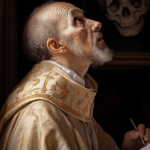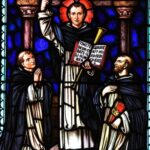St. Faustina Kowalska
St. Faustina Kowalska
When she lived:
St. Faustina Kowalska was born on August 25, 1905, in Głogowiec, a small village in Poland. She lived a
relatively short but impactful life, passing away on October 5, 1938, in Krakow, Poland, at the age of 33.
Where she lived:
St. Faustina spent most of her life in Poland. She lived in various cities, including Warsaw and Krakow. Her
time in these cities was marked by her religious experiences and the formation of her spiritual mission.
Notable world events during the time of her life:
- World War I (1914-1918): This global conflict significantly impacted Europe and the world. It saw the rise of
new nations, changes in political boundaries, and the beginning of modern warfare techniques. - Russian Revolution (1917): The overthrow of the Russian monarchy and the subsequent establishment of the
Soviet Union had profound geopolitical implications and shaped the course of the 20th century. - Women’s Suffrage Movement: Throughout the early 20th century, women in various countries, including the United
States and parts of Europe, were actively advocating for the right to vote, leading to significant social and
political changes. - Roaring Twenties: A period of cultural and social revolution, marked by significant advancements in technology,
music, and the arts. Jazz, the flapper culture, and the rise of consumerism characterized this era. - Great Depression (1929-1939): The global economic crisis had widespread consequences, causing widespread
unemployment, poverty, and social upheaval.
Patronage:
St. Faustina Kowalska is widely known as the “Apostle of Divine Mercy.” Her deep devotion to the concept of Divine
Mercy, as well as her messages and experiences of Christ’s mercy, have made her the patron saint of mercy,
forgiveness, and compassionate love. She is also a patron saint for a world in need of hope, healing, and
reconciliation. Additionally, she is a patron for painters and artists, reflecting her own artistic talents and
the divine inspiration she received for creating the Divine Mercy image.
Her Desire to Be a Religious
Sister Faustina Kowalska was born on August 25, 1905, in the small Polish town of Glogowiec. She belonged to a poor yet religious family of peasants. She was the third of ten children. She was baptized with the name Helena in the parish church of Swinice Warckie.
From a very young age, Helena stood out because of her love of prayer, piety, work, and obedience. Above all, she had a deep love for and sensitivity for the poor. When she was seven, she had already felt the first indications of a vocation to religious life. She received First Holy Communion at nine, which she described as a very profound moment.
Helena attended school for only three semesters. She wanted to enter the convent. However, her parents would not grant her permission. At sixteen, she left home and worked as a housekeeper in Aleksandrów, Lodi, and Ostrówek in order to support herself and her parents. She was obedient to her parents, but the desire to enter the religious life never left her.
The Humble Sister Faustina
When she was nineteen, Helena claimed that she had a vision in which God told her to go to a vast city in Poland and enter the convent. It is said that she took the next train to Warsaw. She tried joining several religious orders. However, they turned her down because of her lack of education. Finally, the Mother Superior of the Servants of Our Lady of Mercy decided to give her a chance. Helena was given the name Sister Maria Faustina of the Blessed Sacrament.
Sister Faustina worked in menial jobs that did not require education, such as cooking, gardening, and housekeeping. Despite this, she was blessed by visions of Christ, who handed her a special mission. Jesus wanted her to spread devotion regarding the mercy of God. He wanted her to help people remember that the Father is merciful and loving to all, even those who have gone astray in sin.
The Secretary of Mercy
In another vision, Jesus asked the nun to have a portrait painted of the Lord as the King of Divine Mercy. He also asked Sister Faustina to be a living example of mercy for others and to make sacrifices for them in imitation of Christ. Sister Faustina did what Jesus asked. But when the other nuns made fun of her and said her visions were not true, she forgave them.
As advised by her spiritual director, Sister Faustina kept a diary of her experiences and visions. Because of her poor education, the diary was difficult to read. However, after Sister Faustina’s death, the spellings were corrected, and her diary was sent to the Vatican.
Consumed by tuberculosis and by numerous sufferings, which she unhesitatingly accepted as sacrifice for others, Sister Faustina died in Krakow on October 5, 1938, at the age of thirty-three. She had a reputation for spiritual maturity and a mystical union with God. Her reputation for holiness grew, as did her devotion to the Divine Mercy and the graces granted through her intercession. Pope John Paul II beatified Sister Faustina on April 18, 1993. On April 30, 2000, the same Pope canonized her. Her feast day is October 5.
Five Interesting Facts About St. Faustina Kowalska
- St. Faustina Kowalska is known as the Apostle of Divine Mercy.
- The remains of St. Faustina Kowalska rest at the Sanctuary of the Divine Mercy in Krakow-Lagiewniki.
- Other than her visions, St. Faustina Kowalska also experienced many extraordinary graces, such as ecstasies, the gift of bilocation, hidden stigmata, reading into human souls, and a mystical betrothal and nuptial.
- The original portrait of the Divine Mercy was painted by an artist by the name of Eugene Kazimirowski. St. Faustina described her vision and provided the details so that the portrait may be as accurate as possible.
- St. Faustina Kowalska saw visions of heaven, purgatory, and hell. These were all written in her Diary.
Prayer to St. Faustina Kowalska
O God, who in a wondrous manner revealed the inexhaustible riches of your mercy to Saint Maria Faustina, grant, we beseech you,that by looking with trust upon the pierced side of your Son, we may be strengthened to show mercy one to another and, at length, sing forever of your mercy in heaven. Through our Lord Jesus Christ, your Son, who lives and reigns with you in the unity of the Holy Spirit,God, forever and ever Amen.



